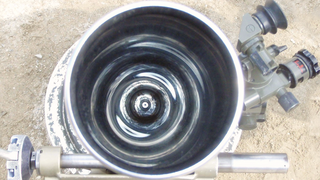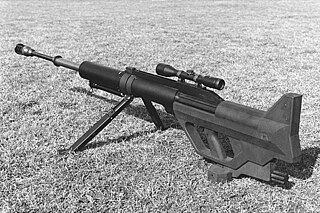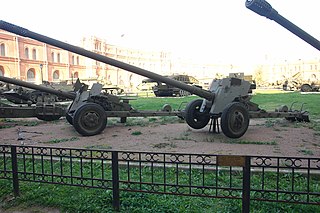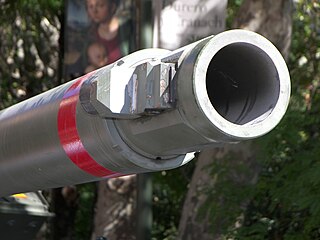
A kinetic energy penetrator (KEP), also known as long-rod penetrator (LRP), is a type of ammunition designed to penetrate vehicle armour using a flechette-like, high-sectional density projectile. Like a bullet or kinetic energy weapon, this type of ammunition does not contain explosive payloads and uses purely kinetic energy to penetrate the target. Modern KEP munitions are typically of the armour-piercing fin-stabilized discarding sabot (APFSDS) type.

A bullet is a kinetic projectile, a component of firearm ammunition that is shot from a gun barrel. They are made of a variety of materials, such as copper, lead, steel, polymer, rubber and even wax; and are made in various shapes and constructions, including specialized functions such as hunting, target shooting, training, and combat. Bullets are often tapered, making them more aerodynamic. Bullet size is expressed by weight and diameter in both imperial and metric measurement systems. Bullets do not normally contain explosives but strike or damage the intended target by transferring kinetic energy upon impact and penetration.

Armour-piercing ammunition (AP) is a type of projectile designed to penetrate armour protection, most often including naval armour, body armour, vehicle armour.

Terminal ballistics is a sub-field of ballistics concerned with the behavior and effects of a projectile when it hits and transfers its energy to a target.

A high-explosive squash head (HESH), in British terminology, or a high-explosive plastic/plasticized (HEP), in American terminology, is a type of explosive projectile with plastic explosive that conforms to the surface of a target before detonating, which improves the transfer of explosive energy to the target. Squash head projectiles are similar to high-explosive projectiles and are well suited to many of the same targets. However, while HESH projectiles are not armour-piercing, they can defeat armored targets by causing spall, which can injure or kill a vehicle's occupants or detonate some types of ammunition.

High-explosive anti-tank (HEAT) is the effect of a shaped charge explosive that uses the Munroe effect to penetrate heavy armor. The warhead functions by having an explosive charge collapse a metal liner inside the warhead into a high-velocity shaped charge jet; this is capable of penetrating armor steel to a depth of seven or more times the diameter of the charge. The shaped charge jet armor penetration effect is purely kinetic in nature; the round has no explosive or incendiary effect on the armor.
Muzzle velocity is the speed of a projectile with respect to the muzzle at the moment it leaves the end of a gun's barrel. Firearm muzzle velocities range from approximately 120 m/s (390 ft/s) to 370 m/s (1,200 ft/s) in black powder muskets, to more than 1,200 m/s (3,900 ft/s) in modern rifles with high-velocity cartridges such as the .220 Swift and .204 Ruger, all the way to 1,700 m/s (5,600 ft/s) for tank guns firing kinetic energy penetrator ammunition. To simulate orbital debris impacts on spacecraft, NASA launches projectiles through light-gas guns at speeds up to 8,500 m/s (28,000 ft/s). FPS and MPH are the most common American measurements for bullets. Several factors, including the type of firearm, the cartridge, and the barrel length, determine the bullet's muzzle velocity.

A sabot is a supportive device used in firearm/artillery ammunitions to fit/patch around a projectile, such as a bullet/slug or a flechette-like projectile, and keep it aligned in the center of the barrel when fired. It allows a narrower projectile with high sectional density to be fired through a barrel of much larger bore diameter with maximal accelerative transfer of kinetic energy. After leaving the muzzle, the sabot typically separates from the projectile in flight, diverting only a very small portion of the overall kinetic energy.

A smoothbore weapon is one that has a barrel without rifling. Smoothbores range from handheld firearms to powerful tank guns and large artillery mortars.

The Steyr IWS 2000 is an Austrian single-shot bolt-action anti-materiel rifle produced by Steyr Mannlicher. IWS stands for Infantry Weapon System. Unlike other anti-tank rifle designs, it has a smoothbore barrel. This facilitates higher projectile velocities and allows a longer barrel service life, but the lack of gyroscopic spin-stabilization requires the projectile to have aerodynamic stabilizing fins instead. The IWS is chambered in a 15.2×169 mm armor-piercing fin-stabilized discarding-sabot cartridge, and is the first man-portable rifle to use this type of ammunition.

Armour-piercing discarding sabot (APDS) is a type of spin-stabilized kinetic energy projectile for anti-armour warfare. Each projectile consists of a sub-calibre round fitted with a sabot. The combination of a lighter sub-calibre projectile with a full-calibre propellant charge allows for an increase in muzzle velocity compared to full-calibre rounds, giving the round increased armour-penetration performance. To further enhance their armour-penetration capabilities, APDS rounds typically feature a hardened core made from tungsten or another hard, dense material.

A tank gun is the main armament of a tank. Modern tank guns are high-velocity, large-caliber artilleries capable of firing kinetic energy penetrators, high-explosive anti-tank, and cannon-launched guided projectiles. Anti-aircraft guns can also be mounted to tanks.

2A19 or T-12 is a Soviet-designed 100-mm anti-tank gun. It was the first anti-tank gun to adopt a smoothbore barrel, and to introduce modern armor piercing shot, like the APFSDS. It uses long projectiles that are more powerful than its caliber suggests. The T-12 served as the primary towed anti-tank artillery in the Soviet and Bulgarian armies from the early 1960s to the late 1980s.
The following is a list of ammunition fired by the 125 mm smoothbore gun series used in the T-64, T-72, T-80, M-84, T-90, PT-91, T-14 Armata, and other tanks derived from those designs, as well as the 2A45 Sprut anti-tank gun.

Armor-piercing bullets for rifle and handgun cartridges are designed to penetrate ballistic armor and protective shields intended to stop or deflect conventional bullets. Although bullet design is an important factor with regard to armor penetration, the ability of any given projectile to penetrate ballistic armor increases with increasing velocity. Rifle cartridges typically discharge bullets at higher muzzle velocity than handgun cartridges due to larger propellant charge. However, even the same cartridge fired from a rifle will, in almost all common cases, have a higher velocity than when fired from a handgun. This is due to the longer period of acceleration available within the longer gun barrel of rifles, which allow adequate time for the propellant to fully ignite before the projectile exits the barrel. For this reason, bullets fired from rifles may be more capable of piercing armor than similar or identical bullets fired from handguns. In addition, a small-caliber bullet has higher sectional density than a larger-caliber bullet of the same weight, and thus is more capable of defeating body armor.

The Rheinmetall Rh-120 is a 120 mm smoothbore tank gun designed and produced in former West Germany by the Rheinmetall-DeTec AG company, it was developed in response to Soviet advances in armour technology and development of new armoured threats. Production began in 1974, with the first version of the gun, known as the L/44 as it was 44 calibres long, used on the German Leopard 2 tank and soon produced under license for the American M1A1 Abrams and other tanks. The 120-millimetre (4.7 in) gun has a length of 5.28 metres (17.3 ft), and the gun system weighs approximately 3,317 kilograms (7,313 lb).

The 14.5×114mm is a heavy machine gun and anti-materiel rifle cartridge used by the Soviet Union, the former Warsaw Pact, modern Russia, and other countries.

The M829 is an American armor-piercing fin-stabilized discarding sabot (APFSDS) tank round. Modeling was done at the Ballistic Research Laboratory at Aberdeen Proving Ground, which was incorporated into the Army Research Laboratory in 1992. The round is specifically designed for the 120 mm M256 main gun on the Abrams M1A1 and M1A2 main battle tanks. The penetrator is carried by a sabot during its acceleration in the gun barrel.

The L30A1, officially designated Gun 120 mm Tk L30, is a British-designed 120 mm rifled tank gun, installed in the turrets of Challenger 2 main battle tanks. It is an improved production model of the Royal Ordnance L11 series of rifled tank guns. Challenger 2 tanks, and their L30A1 guns, are operated by the British and Omani armies. In 2023, L30A1 armed Challenger 2 tanks supplied by the British were delivered to Ukraine.

The Royal Ordnance L11A5, officially designated Gun 120 mm Tk L11, is a 120 mm L/55 rifled tank gun design. It was the first of NATO's 120 mm main battle tank guns which became the standard calibre for Western tanks in the later period of the Cold War. A total of 3,012 of the L11 guns were produced by 2005. The list price was US$227,000 in 1990.

















